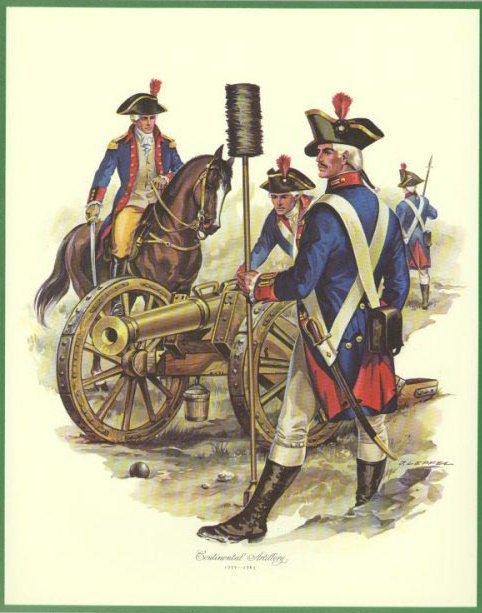![[Ealge with Flag]](eagle1.gif)
| UNIFORMS
OF
THE AMERICAN REVOLUTION At the beginning of the American Revolution the forces besieging the British in Boston were very weak n artillery. There were a number of scattered militia artillery companies, and some of these were soon combined to form sizeable and effective units. In April, 1775, the United Train of Artillery of Providence was formed from the Providence (Rhode Island) Train Band of Artillery, Providence Fusileers, and Massachusetts formed a regiment of six companies under Colonel Gridley. In June of the same year, Philadelphia had a company of 150 men with two twelve-pound and four six-pound field pieces. New York formed a company under Captain John Lamb in July, 1775, and, in March of the following year a second company was organized under Captain Alexander Hamilton. Many of these companies witnessed action -- Gridley's men at Bunker Hill, Lamb's company at Quebec, and Hamilton's men at Trenton. No other branch of the services owes so much to one man as does the Artillery to Henry Knox. Appointed Colonel by General Washington, he took over the Massachusetts Artillery. Under Knox's leadership the regiment became a well-trained fighting unit. Knox went to Fort Ticonderoga and brought back 59 pieces of artillery for the use of the army before Boston. It was with these guns that Washington's troops were able to fortify Dorchester Heights and to speed up the evacuation of Boston by General Howe. There were four regiments in the Continental Artillery. Detachments from these regiments fought in nearly all of the later actions of the war. Colonel Charles Harrison's First Regiment fought at Camden and Hobkirk's Hill in South Carolina, Colonel John Lamb's Second Regiment saw action at Forts Clinton and Montgomery in New York, Colonel Thomas Proctor's Fourth Regiment took part in Sullivan's Campaign and in the Battle of Brandywine, while Colonel John Crane's Third Regiment was Knox's Massachusetts Regiment. Our plate shows the artillery in the blue coats faced with red, with yellow buttons and bindings. This dress was adopted by the Board of War in 1779. It was the dress worn when supplies were available from France. Black coats were also worn in some instances in lieu of the harder-to-obtain dark blue. [REFERENCES: Military Collector and Historian. Vol. 3, Fall, 1965; Vol. XIV, No. 2, Summer, 1962. The War of the Revolution. Christopher L. Ward.] |
| Continental
Artillery
1777-1783
|
|
More Uniforms of the American Revolution | Next Page | Uniforms Index | Return to Main Menu eMail the WebmasterCopyright
Notice
|
